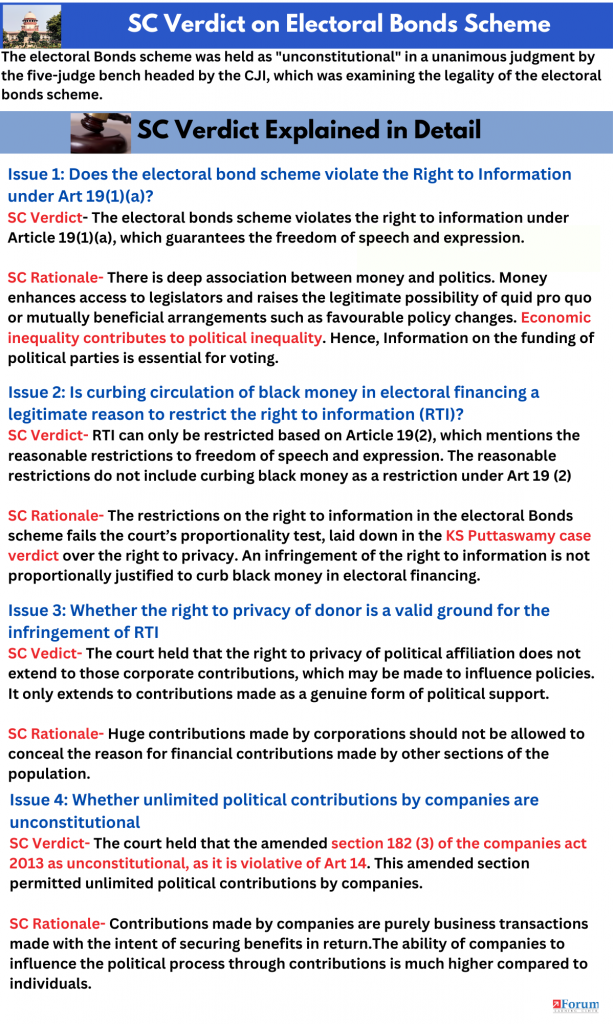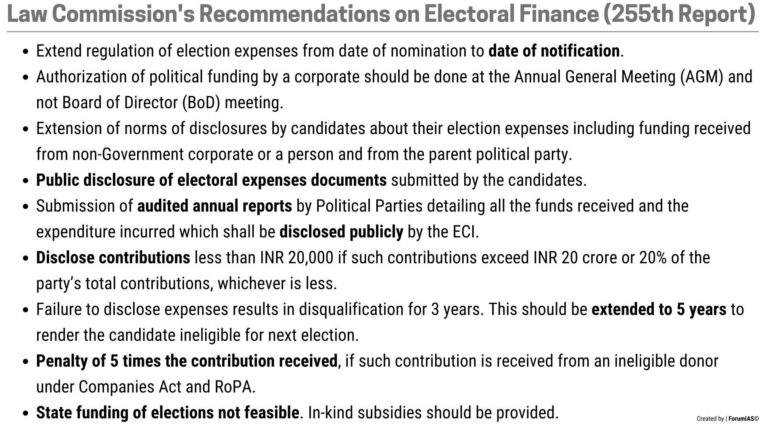ForumIAS announcing GS Foundation Program for UPSC CSE 2025-26 from 19 April. Click Here for more information.
The electoral Bonds scheme was held as “unconstitutional” in a unanimous judgment by the five-judge bench of Supreme Court (SC) headed by the CJI, which was examining the legality of the electoral bonds scheme. SC held that anonymous electoral bonds are violative of right to information and Article 19(1)(a).
Along with the Electoral Bonds Scheme (EBS), the Supreme Court struck down amendments in the The Representation of the People Act, 1951 (RPA), The Income-tax Act, 1961, and The Companies Act, 2013, which were brought to facilitate corporate donations to political parties. Electoral Bond Scheme UPSC

What are the implications of SC Verdict on Electoral Bonds Scheme?
1. After the ‘basic structure doctrine’, SC has drawn a new red line for the state to be ‘least restrictive’- The electoral bonds scheme was invalidated by the court as it held that the state could have employed any other method that could have been ‘least restrictive’ to fundamental rights. SC has established a new red line for the state to be ‘least restrictive’ on fundamental rights, while exercising its legislative functions.
2. Reaffirmation of the principle of “definite” and “structured” proportionality test- SC in its verdict on the electoral bonds scheme has reaffirmed to the principle of ‘definite’ and ‘structured’ proportionality test laid down in the Puttuswamy judgement on the right to privacy. This principle will guard against arbitrary action that could completely wipe out a right in the garb of pursuing even a “legitimate state interest”.
3. Defining ‘legitimate state interest’ not the exclusive purview of the state- According to the ruling, definition of ‘legitimate state interest’ will not be the exclusive purview of the state. The SC will examine the state’s definition of ‘legitimate state interest‘, behind any legislative action, as was done in the case of electoral bonds scheme.
4. Re-affirmation of the right to information as a cardinal virtue of democracy- The verdict re-affirms that the right to information provided under Article 19(1)(a) of the constitution, remains a cardinal principle of Indian democratic setup.
5. Institution of Hierarchy of rights- The Supreme Court in its judgement has used the proportionality test to calibrate a hierarchy of rights. Greater weightage has been assigned to an individual voter’s right to information on political funding than a corporate donor’s demand for a right to privacy.
6. Paramounty of Citizen’s interests- The verdict emphasises the state to keep citizen’s interest paramount while drafting any legislation or policy. For ex- The verdict opens up the door for challenging the State’s aviation and insolvency policies which have favoured corporations over citizens.
What are Electoral Bonds?
| Definition | Electoral bonds are interest-free “bearer instruments”. (Bearer Instruments are similar to promissory notes. These are payable to the bearer on demand) |
| Introduction | Electoral Bonds were introduced with the Finance Bill 2017. The scheme was notified on January 29, 2018. |
| Eligibility of Donors | (1) Any citizen of India or entities incorporated or established in India can purchase these Bonds. (2) Citizens can buy electoral bonds either singly or jointly with other individuals. |
| Eligibility of Political Parties | Only political parties registered under Section 29A of the Representation of the People Act, 1951 and which secured not less than 1% of votes polled in the last general election to the House of the People or the Legislative Assembly of the State, are eligible to receive electoral bonds. |
| Functioning of the Electoral Bond Scheme | (1) The State Bank of India (SBI) issues electoral bonds in the months of January, April, July and October. (2)The electoral bonds are available in denominations from Rs 1,000 to Rs 1 crore. (3)The donors can buy electoral bonds and transfer them into the accounts of the political parties as a donation. The name of the donor is kept confidential. (4) Political parties create a specific account. This account is verified by the ECI. The political parties encash the electoral bonds only in this verified account. (5)The bonds remain valid for 15 days. Within that time, the political parties have to encash the electoral bond in the designated accounts. |
What was Govt’s rationale behind the introduction of Electoral Bonds Scheme in 2018?
1. Transparency in political funding- Electoral bonds would provide a transparent route for parties to collect funds, as electoral bonds are allowed to be sold only through SBI and to KYC validated individuals only.
2. Reduced chances of misuse of bonds- A limited window for the sale of these bonds and a very short maturity period (life of bonds is only 15 days),would make the misuse of these bonds difficult.
3. Protection of anonymity- The bearer bonds would provide anonymity to donors which prevent their post-poll intimidation or harassment by political opponents.
4. Political accountability- The political parties are required to submit the details about contributions received through electoral bonds to the Election Commission which would ensure their accountability.
5. Reduction of use of black money for Political Funding- Under the Electoral bond scheme, the amount of money that a party can accept in cash from anonymous sources has reduced from Rs 20,000 to Rs 2,000. This would reduce the use of black money in the elections.
What were the arguments against Electoral Bonds?
1. Against the ‘Right to Know’- Electoral bonds donations to political parties hide the identity of the donors and recipients. Before the introduction of electoral bonds, political parties had to disclose details of all its donors, who have donated more than Rs. 20,000. Hence, electoral bonds compromise the citizen’s ‘Right to Know’, which is part of the right to information under Article 19 (1) of the Constitution.
2. Information asymmetry– Principle of anonymity does not apply to the government of the day, which can always access the donor details by demanding the data from the State Bank of India (SBI). The bonds provide a ruling party with a chance to threaten the donors of the opposition party.
3. Loopholes in transparency of donation limits from corporate entities- The electoral Bond scheme removed the clause of the Companies Act 2013. As per the previous clause of the Companies Act 2013, a company could make a political contribution only if its net average profit of three preceding financial years was 7.5%. The removal of this clause has raised concerns of black money in political funding through shell companies.
4. Compromised the rights of shareholders of company- The electoral bonds scheme allows companies to “funnel money” to political parties without any oversight from shareholders. This denies the shareholders, who are also the owners of the company, the ability to decide how their company should act in the political sphere.
5. Flawed argument of donor anonymity- For decades, corporations have made donations to Indian political parties, and often, the same donors have funded rival parties. There haven’t been instances of any ruling party targeting a donor who contributed to its political opponents.
6. Leading to Crony-Capitalism- Electoral bonds may become a convenient channel for businesses to round-trip their cash parked in tax havens to political parties for a favour through shell companies.
7. Rise in large donations from corporates- One of the main arguments for introduction of electoral bonds was to allow common people to easily fund political parties of their choice, but more than 90% of the bonds have been of the highest denomination (Rs. 1 crore).
8. Passage of electoral Bonds Scheme as Money Bill- The passage of Electoral Bonds scheme as money bill by-passed the scrutiny of Rajya Sabha.
9. Issue of Foreign funds- Representation of the People Act, 1951, prohibits political parties from accepting contributions from foreign sources, and Section 3 of the 2010 Foreign Contributions (Regulation) Act restricts foreign contributions to candidates, legislative members, political parties and party office holders.
However, the government passed a retroactive amendment which effectively shields any foreign financing of Indian elections from scrutiny.
10. Against RBI’s sole authority of issuance of bearer instruments- Electoral Bonds Scheme allowed only the SBI to issue Electoral bonds. This militated against RBI’s sole authority for issuing bearer instruments which had the potential of becoming currency.
11. Veil of Secrecy- Donation received by a political party through electoral bond was kept out of the ambit of reporting under the Contribution Report as prescribed in the Representation of the People Act 1951. This was a retrograde step in ensuring transparency of political donations.
12. Undermines the basic structure- Free and fair elections and the integrity of our electoral process have been repeatedly declared by the Supreme court as a part of the basic structure of the constitution. Free and fair elections are impossible without transparency in political funding.
| Read More- Issues in Electoral Funding in India – Explained, pointwise |
What should be the Way Forward?
1. State funding of Elections- The Indrajit Gupta Committee on State Funding of Elections has supported partial state funding of recognised political parties. State funding has proved its effectiveness in a number of countries like Germany, Japan, Canada, Sweden etc.
2. Explore setting up of National Electoral Fund- An alternative to electoral bonds is a National Electoral Fund to which all donors can contribute. The funds can be allocated to political parties in proportion to the votes they get. This will protect the identity of donors. Apart from that, it would also weed out black money from political funding.
3. Capping of anonymous donations to political parties- The Law Commission of India in its 255th Report has recommended to cap the entire donation received through anonymous sources at Rs. 20 crores or 20% of the total funding of a political party.
4. A complete ban on cash donations- One of the transparency measures for political funding is to put a complete ban on cash donations by individuals or companies to political parties. At present, political parties can receive cash donation below Rs.2000.
5. Implementation of ECI’s recommendation to ensure transparency in political funding- Companies contributing to political parties must declare party-wise contributions in the profit and loss account to maintain transparency in the financial funding of political parties
6. Audit of accounts of political parties- Venkatachaliah Committee Report (2002) has recommended strict regulatory frameworks for auditing and disclosure of party income and expenditure.
7. Learning and implementing global best practices-
a. The Publicity Act (USA), Elections and Referendums Act 2000 (UK) and the EU regulations have all set restrictions on the donations that a political party can accept and mandates the disclosure of source of the donations.
b. France has banned all forms of corporate funding in 1995 and capped individual donations at 6,000 Euros.
c. Brazil and Chile have also banned corporate donations after a series of corruption scandals emerged related to corporate funding.

Conclusion
A clean & transparent electoral funding process is vital to ensure a fair electoral democracy. Most developed countries in the West have robust mechanisms to ensure transparency in their political systems. As India aspires to emulate the West by setting the ambition of achieving developed country status by 2047, it must aspire for similar standards of transparency in the political sphere. Cleaning up electoral finance can be the first step in this regard.
| Read More- Indian Express Syllabus- GS-2 -Salient Features of the Representation of People’s Act. |




